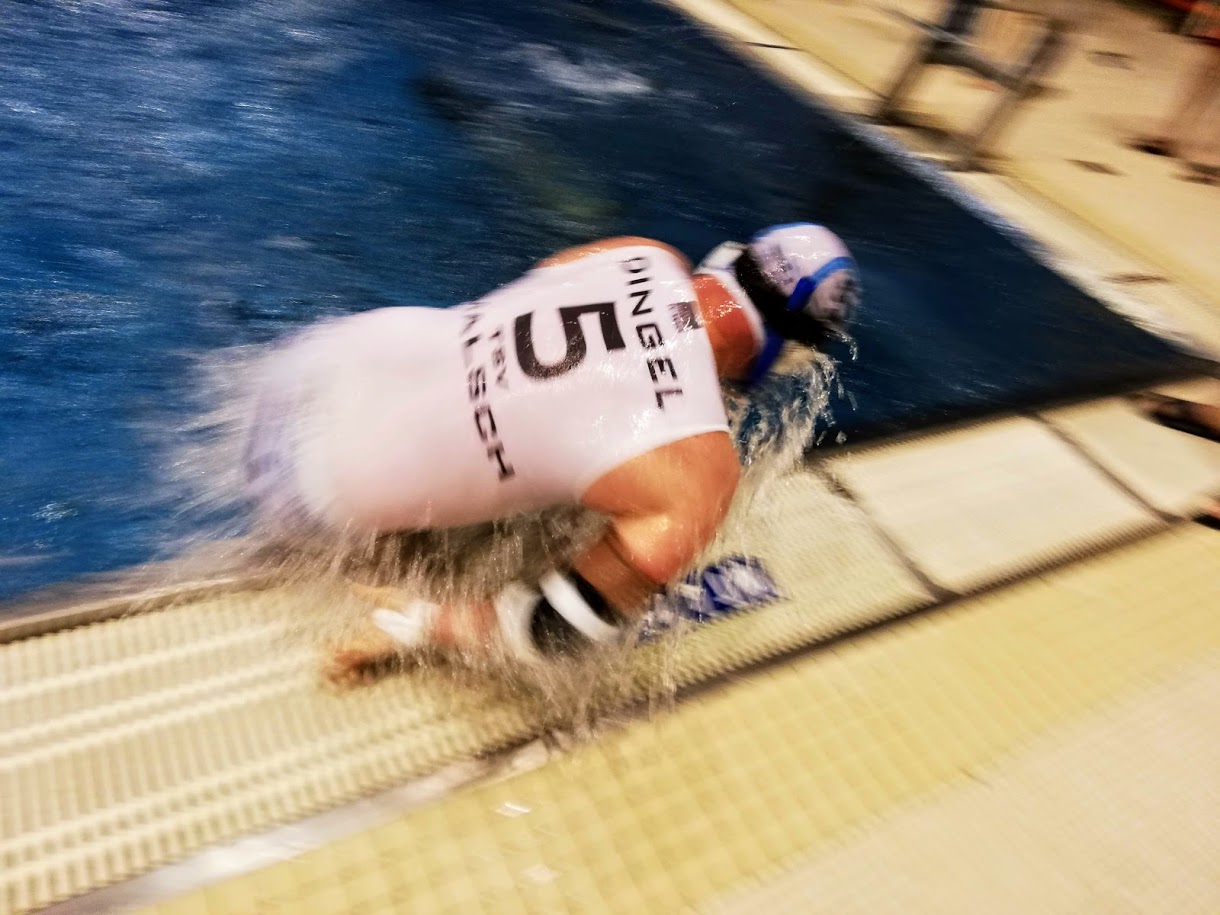Even elite teams cannot prevent goal stealers 100 percent of the time; basket theft can be the game changer.
On land the players waiting to dive in lean forward in their plastic chairs, trying decipher what is going on. A forward on the offensive team makes a long exchange and new one leaps in.
Before the entrant spots the ball he sees that a teammate has stolen the basket because the other team’s goalies are frantically trying to regain control of it. But who has the ball?
Suddenly at midpool he discovers it being handed to him. Who on his team passed it he barely sees because he is now concentrating on the opportunity to score. With every bit of speed he can muster he bursts into close range of the opponent’s basket. The teammate on the goal rises up to create a gap and in the ball goes.
When the scorer surfaces with raised fist, a couple back on the bench salute back with both arms above their heads. The pool rings with a gutterl shout of joy. On the other side players drag themselves from the water and shuffle to the bench, swearing in anger at the mistake that shouldn’t have happened.
Stolen basket goals often feel slightly unreal.
A defined strategy
Should teams have a defined strategy to steal baskets? In this post match interview Malsch’s Jens Dingel talks about a stolen basket goal against Flipper that broke open the game, which finished 3-0 in the German club’s favor. Also a national team veteran, Dingel warns against committing too much effort to basket stealing.
“Once the opponents know you are always trying to steal the basket, they will shut it down,” he explained in an interview for this article. “A player who is too involved in stealing the basket will be missing from action and perhaps be letting his teammates down.”
Dingel has a point. Clearly a stolen basket can go stale if the ball gets tied up on the surface. As the scrum drifts further and further from the basket the heroic diaphragm contractions of the basket thief lapse into irrelevance.
Rule 1: Never park on the basket when your teammates cannot reach you.
Keeping up your guard
Although Dingel places a high standard on his attempts to steal the basket, he clearly loves doing it. He studies the opposition goalies to see if their exchanges are careless. If a goalkeeper does not make certain that the player exchanging is his partner, an opponent like Dingel may sneak in like a cuckoo bird on the song bird’s nest. He delights in mimicking the defending goalie’s partner.
As a team meet tougher opposition, goalkeepers must be aware that the the thieves bring more sophistication to their larceny. A pattern of exchange that has blind spots will be visible to the super bandit.
Rule 2: Maintain vigilance and eye contact – Don’t make Dingel’s day.

Øystein Skarholm (far left) with the reigning Nordic and European women champions. Photo: Cecilia Skåre
I do not believe in setting up one player to fish for the goal instead of being a part of building the attack. That is too obvious and a waste of resources.”
– Øystein Skarholm
Norwegian Women’s
National Team Coach
Every player should be ready take the opponent’s basket without hesitation. Øystein Skarholm, coach of the Norwegian women’s National Team, expects all of this players to keep their eye out for the opportunity.
“We have several players who will take the goal when the opportunity arises. I strongly believe in taking the basket if the opponent leaves it empty.”
The stolen basket is a good way to gain offensive momentum, according to Skarholm. “Steal the basket and push to score.”
When an opponent begins to play very offensively the opportunities to steal the basket will naturally increase.
Rule 3: Stealing the basket is a good counter to an over extended offense.
Rule 4: When the other team has a one point lead and time is running out, stealing the basket is a means of equalizing.
The role of free throws
Free throws present an opportunity. The moment the referee halts the action some players will be distracted trying to find out who is getting the ball. If the opposing goal keepers are looking at the referee, they may lose sight of an opponent sneaking close from a dead angle. Suddenly the offensive player will sprint, hoping to beat the goalkeeper down. Not infrequently a player from each team will arrive at almost the same time and end up splitting the basket. There will always be contact and the defending goalie is likely to push hard.
Who is violating the no contact rule? Both. Is the referee going to call someone? Maybe, maybe not. Rightly or wrongly, the defending goalie enjoys a slight moral advantage. The successful goal stealer must match the defender’s effort without appearing excessively physical.
Rule 5: When stealing the goal the offensive player must act like the legitimate owner to prevent the defending goalkeeper from pushing them off.
Dingel believes that elite teams generally do not leave the basket vulnerable during free throws. This may be true when Bamberg meets Malsch, but in the Euroleague where some players don’t speak the same language or when national teams are a loose constellation from all corners of the country, miscommunication is possible. There are also potential distractions: a careless player exchange, equipment adjustment, dispute with the referee, etc. with any number of causes may divert attention from the basket.
This is especially important for the player who is taking the freethrow, they need to glance at the basket to make certain that they spot the the stolen basket opportunity. Need it be said, a free throw taker who is oblivious to the stolen the basket is not doing their job. And there are some team captains who would not look favorably upon the mistake in a big match.
Rule 6: Pay attention when free throws occur.
If the opposing team is intentionally fouling a great deal to slow the game down – something typically happens when experienced older player want to slow down younger fitter players – the faster team needs to steal the goal to punish them. The experienced team fouls flagrantly because they do not fear the attack from a free throw, but they will if they lose the basket. Here it helps to have a good coach who can remind players to do this.
Rule 7: Punish the teams that tactically foul a great deal by stealing the basket.
The goalie stripping scrum
Besides the free throw, one of the best opportunities comes when an attack from above causes the goalkeeper to lock up with attacker and float upwards. This subaquatic scrum creates fissure that can allow an attacking player to take the goal before the defending team can stabilize the situation.
Rule 8: Players who lock up the goalie should fight to stay as deep as they can above the goal to create the goal stealing gap.
Technical details
Often the players who steal the basket are goalies or backs. But a forward who feels more comfortable stomach down is also fine. In fact, the sight of someone lying the wrong way is a signal to a team that something is wrong on the opponent’s side. The thief does not have to fit like a lid; the main point is to dominate the space above the goal.
If a teammate who has been guarding a stolen basket needs relief, someone should substitute with him to keep the opponents under pressure. A successfully exchanged stolen basket will stress the defending goalies enormously.
A coach like Tomi Suomalainen will usually call timeout when his team’s basket has been stolen. Depriving an opponent of a time out is an obvious gain.

Lilo and Camilo Diaz at Champions Cup in Berlin. Photo: Lilo Diaz
Knowing who is a threat
Skarholm admitted that several of his players are good stealing the basket, but he declined to name any particular one.
“I don’t have any focus on who is doing it, as this will come naturally during the game. I push hard for individualism,” said the Norwegian coach, who is not in favor of any rigid systems.
“I tell the players to change their minds in a split second if the game changes. Surprize your yourself and you surprize the opponent.”
When the question was put to Amanda Barsten, she laughed: “Well many of us. Just ask someone on our national team.” Berit Detlie did not reply to the question. I did not bother to ask Cecilie Skåre. She wouldn’t supply intelligence on her own team. So, to find out who the top thieves are it is necessary to watch the game films if there are any.
There is one player famous for stealing the basket: Orcas’ Camilo Diaz. His sister and clubmate Lilo Diaz offered the following explanation.
“It is his personality… he is a cheeky monkey, haha!”
– Lilo Diaz
Orcas teammate
“Also, I think he excels at it because he is a “‘small” player. He developed this skill to be able to make goals, and he has found the way.”
Cover photo: Davrell Tien


